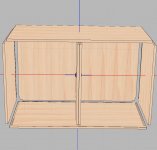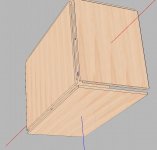Bugsysiegals
Member
- Joined
- Mar 19, 2016
- Messages
- 908
I'm building cabinets for my basement wood shop, laundry room, pantry, kitchen, bathroom, etc., and am confused which joinery method to use. Cabinets will be made of 19mm (3/4") Maple veneer plywood which is prefinished on one side.
My main struggle is that these are all going to be frame-less cabinets and to me it looks incorrect to have the front edge banding with a visible Dado joint where end panels meet the top and bottom panels. They will have full overlay drawers but that's no excuse to do it incorrectly ... do you agree this is not a visually appealing joinery for frame-less cabinets? In my mind, the edge banding on frame-less cabinets should be like the Roman numeral II with horizontal edge banding extending flush to the sides and vertical edge banding running flush between them ... am I wrong?
FWIW - I've ripped Maple hardwood down to 3mm thick strips and plan to glue it to the exposed panel edges so I can hand plane it flush before cabinet assembly. I suppose I could get away with Full Dado's if I glued it on afterwards but I don't think I could get 3mm edge banding flush after the fact and I'm fairly certain most people apply edge banding prior to assembly? I want to use a joinery method which not only lasts many years but is easily repeatable so by the time I get to the kitchen, everything is aligning nicely, and I'm able to create something I can be proud of for years to come....
As far as related tools are concerned for these joinery methods, I have a lot of tools and I've included the ones I think would be most useful for this project .... Festool Domino XL with Seneca adapter for smaller wood, OF1400 router/guide rails, LR32, MFT/3, SawStop with Incra fence system and extended router table wing with 3HP router and Incra lift, Craig Jig, digital calipers, etc., etc.
FYI - With regards to the base cabinet model I've attached, the top/bottom is flush with the sides rather than the sides being flush with the top/bottom like kitchen cabinets because this is for my shop cabinets which will sit on top of 4 swivel casters. I'm not sure how heavy the items in the drawers may be and I may even use these them as outfeed tables / saw horses, if they can support the weight, so I'm trying to minimize any sagging.
My main struggle is that these are all going to be frame-less cabinets and to me it looks incorrect to have the front edge banding with a visible Dado joint where end panels meet the top and bottom panels. They will have full overlay drawers but that's no excuse to do it incorrectly ... do you agree this is not a visually appealing joinery for frame-less cabinets? In my mind, the edge banding on frame-less cabinets should be like the Roman numeral II with horizontal edge banding extending flush to the sides and vertical edge banding running flush between them ... am I wrong?
FWIW - I've ripped Maple hardwood down to 3mm thick strips and plan to glue it to the exposed panel edges so I can hand plane it flush before cabinet assembly. I suppose I could get away with Full Dado's if I glued it on afterwards but I don't think I could get 3mm edge banding flush after the fact and I'm fairly certain most people apply edge banding prior to assembly? I want to use a joinery method which not only lasts many years but is easily repeatable so by the time I get to the kitchen, everything is aligning nicely, and I'm able to create something I can be proud of for years to come....
As far as related tools are concerned for these joinery methods, I have a lot of tools and I've included the ones I think would be most useful for this project .... Festool Domino XL with Seneca adapter for smaller wood, OF1400 router/guide rails, LR32, MFT/3, SawStop with Incra fence system and extended router table wing with 3HP router and Incra lift, Craig Jig, digital calipers, etc., etc.
FYI - With regards to the base cabinet model I've attached, the top/bottom is flush with the sides rather than the sides being flush with the top/bottom like kitchen cabinets because this is for my shop cabinets which will sit on top of 4 swivel casters. I'm not sure how heavy the items in the drawers may be and I may even use these them as outfeed tables / saw horses, if they can support the weight, so I'm trying to minimize any sagging.












